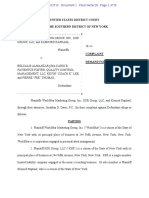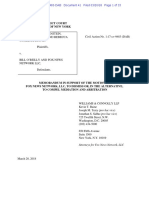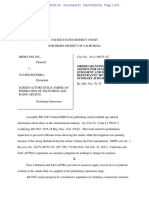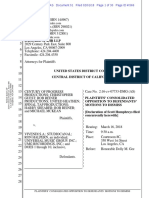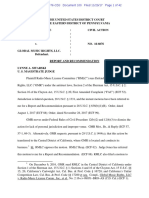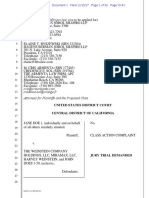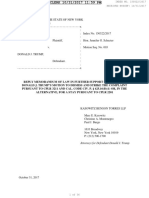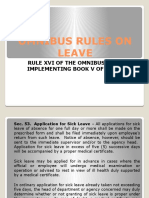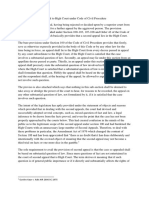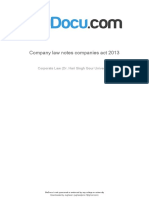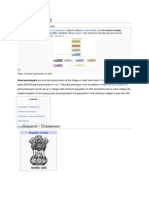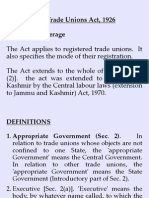Professional Documents
Culture Documents
Newgirl Ideatheft
Uploaded by
Eriq GardnerCopyright
Available Formats
Share this document
Did you find this document useful?
Is this content inappropriate?
Report this DocumentCopyright:
Available Formats
Newgirl Ideatheft
Uploaded by
Eriq GardnerCopyright:
Available Formats
Case 2:14-cv-00396-SVW-CW Document 107 Filed 06/12/15 Page 1 of 11 Page ID #:2154
Case 2:14-cv-00396-SVW-CW Document 107 Filed 06/12/15 Page 2 of 11 Page ID #:2155
Contract/Theft or Conversion.
Presently before the Court is Defendants motion to dismiss Plaintiffs Breach of
Contract/Theft or Conversion claim. As set forth below, the Court GRANTS Defendants
motion and DISMISSES WITH PREJUDICE Plaintiffs Breach of Contract/Theft or
Conversion claim.
II.
BACKGROUND
The facts are well-known to the parties and are recited at length in the Courts October
15, 2014 Order. (Dkt. 86.) The Court therefore only briefly touches upon the facts as they relate
to the instant motion.
10
Plaintiffs are a professional screenwriting duo. (TAC 1.) In 2006 they wrote their pilot
11
script, Square One. (Id.) They subsequently expanded the pilot into a feature-length script, two
12
versions of which are at issue in this action. (TAC 37, 50.)
13
On February 17, 2011, Plaintiffs purportedly learned that Defendants Chicks and Dicks
14
script used their Square One material. (TAC 67.) Chicks and Dicks is the pilot episode of the
15
television series New Girl. (TAC 80, 88.) On September 20, 2011, New Girl premiered on
16
defendant Fox Broadcasting Companys channel. (TAC 89.)
17
Plaintiffs claim that they retained counsel in early 2011 and then informed Defendants
18
that Defendants were infringing on Square One. (TAC 97.) Plaintiffs assert that in June 2011
19
they paid their then attorneys a $10,000 retainer to pursue their case against Defendants. (TAC
20
340.) According to Plaintiffs, their then attorneys, who are supposedly representing Plaintiffs
21
interests, tell Plaintiffs that the law firm represented the executive producer and director of New
22
Girldefendant Jacob Kasdanand his family, but that it is okay for this law firm to represent
23
Plaintiffs, just so long as Plaintiffs refrain from suing Kasdan. (TAC 98.) Plaintiffs assert
24
that their then attorneys told them in writing:
25
26
27
28
Regarding the potential Jake Kasdan connection, both Jake Kasdan and his
father are long time clients of the firm. We therefore cannot take a position
that is adverse to Jake Kasdan. Due to our long-standing relationship with
the Kadan, if we were to assert allegations that implicated Jake Kasdan, we
likely could be disqualified in this action and, therefore, would be prohibited
from continuing to represent you in connection with this dispute. While we
feel that the connection to Jake Kasdan is a bit attenuated (based on the facts
set forth in your email), if this is something you would like to pursue, we
2
Case 2:14-cv-00396-SVW-CW Document 107 Filed 06/12/15 Page 3 of 11 Page ID #:2156
1
2
would need to discuss our further involvement in this matter.
(TAC 98 n.10.)
In mid-2011, the Fox defendants purportedly negotiated with Plaintiffs then attorneys.
(TAC 98.) In January 2012, the Fox defendants offered Plaintiffs $10,000 to settle this matter.
(TAC 103.) Plaintiffs, insulted, obviously reject Foxs settlement offer and terminate their
relationship with their then conflicted attorneys in February 2012. (TAC 104.) Plaintiffs
claim that until February 2012, they were unaware of just how tightly aligned Defendants and
their then-counsel were in the entertainment industry: The firm representing Plaintiffs also
absurdly represented the director and executive produce of New Girl, the very show Plaintiffs
10
claimed took their ideas and artistic expression. (TAC 342.)
11
On January 16, 2014, Plaintiffs filed this action against Defendants. (Dkt. 1.) On March
12
4, 2015, this Court issued an Order granting in part Defendants motion to dismiss Plaintiffs
13
Second Amended Complaint (SAC). (Dkt. 96.) In relevant part, the court dismissed without
14
prejudice Plaintiffs breach of implied-in-fact contract claim because it was filed outside the
15
relevant two-year limitations period and neither equitable tolling nor equitable estoppel applied.
16
(Dkt 96: Order at 57.) The Court noted that because this was Plaintiffs second attempt to plead
17
this claim, the next dismissal would be with prejudice. (Id.)
18
III.
19
ANALYSIS
Defendants move to dismiss Plaintiffs claim for Idea TheftBreach of Contract/Theft
20
or Conversion. To the extent that this claim asserts the breach of an implied-in-fact contract,
21
Defendants assert that it is time-barred. To the extent that this is a claim for conversion,
22
Defendants assert that it is preempted.
23
A.
24
A motion to dismiss under Rule 12(b)(6) challenges the legal sufficiency of the claims
Legal Standard for Motion to Dismiss Under Rule 12(b)(6)
25
stated in the complaint. Fed. R. Civ. Proc. 12(b)(6). To survive a motion to dismiss, a complaint
26
must contain sufficient factual matter, accepted as true, to state a claim to relief that is
27
plausible on its face. Ashcroft v. Iqbal, 556 U.S. 662, 678 (2009) (quoting Bell Atlantic Corp.
28
v. Twombly, 550 U.S. 544, 570 (2007)). A claim has facial plausibility when the plaintiff
3
Case 2:14-cv-00396-SVW-CW Document 107 Filed 06/12/15 Page 4 of 11 Page ID #:2157
pleads factual content that allows the court to draw the reasonable inference that the defendant is
liable for the misconduct alleged. Id. A complaint that offers mere labels and conclusions or
a formulaic recitation of the elements of a cause of action will not do. Id. (quoting Twombly,
550 U.S. at 555) (internal quotation marks omitted). Allegations in the complaint, together with
reasonable inferences therefrom, are assumed to be true for purposes of the motion. Odom v.
Microsoft Corp, 486 F.3d 541, 545 (9th Cir. 2007). However, a Court need not accept legal
conclusions as true. Iqbal, 556 U.S. at 678.
8
9
10
11
12
13
14
15
16
17
18
19
20
21
22
23
24
25
26
27
28
If a court dismisses the complaint, it will freely grant leave to amend. DeSoto., 957 F.2d
at 658. In deciding whether to dismiss with prejudice, courts consider the following factors
articulated by the Supreme Court in Foman v. Davis, 371 U.S. 178 (1962):
undue delay, bad faith or dilatory motive on the part of the movant, repeated
failure to cure deficiencies by amendments previously allowed, undue
prejudice to the opposing party by virtue of allowance of the amendment,
futility of amendment, etc.
Id. at 182; see also Sharkey v. O'Neal, 778 F.3d 767, 774 (9th Cir. 2015).
B.
Breach of Implied in Fact Contract
1.
Legal Standard
California law recognizes that an implied-in-fact contract arises when the writer submits
material to a producer with the understanding that the writer expects to be paid if the producer
uses his concept. Desny v. Wilder, 46 Cal.2d 715, 299 P.2d 257 (1956). Such claims are subject
to a two-year limitations period. Benay v. Warner Bros. Entm't, 607 F.3d 620, 632-33 (9th Cir.
2010) (citing Blaustein v. Burton, 9 Cal. App. 3d 161, 185 (Cal. Ct. App. 1970)). California
courts generally assume that a breach of implied-in-fact contract claim accrues on the date on
which the work is released to the general public. Id. at 633 (citing 4 Nimmer 19D.07[D];
Thompson v. Cal. Brewing Co., 191 Cal. App. 2d 506, 510 (Cal. Ct. App. 1961)).
Equitable tolling suspends the statute of limitations as necessary to ensure fundamental
practicality and fairness. Lantzy v. Centex Homes, 31 Cal. 4th 363, 370 (2003). This doctrine
requires a balancing of the injustice to the plaintiff if his claim is time-barred against the effect
on the public policy furthered by the statute of limitations. Id. The doctrine focuses primarily
on the plaintiff's excusable ignorance of the limitations period. . . . [It] is not available to avoid
4
Case 2:14-cv-00396-SVW-CW Document 107 Filed 06/12/15 Page 5 of 11 Page ID #:2158
the consequences of ones own negligence. Sagehorn v. Engle, 141 Cal. App. 4th 452, 460
(Cal. Ct. App. 2006) (quoting Lehman v. U.S. 154 F.3d 1010, 1016 (9th Cir.1998)) (internal
quotation marks omitted).
To establish that equitable tolling applies, a plaintiff must show: (1) timely notice and a
lack of prejudice to defendants, and (2) that she acted reasonably and in good faith. Addison v.
State of California, 21 Cal. 3d 313, 319 (1978). Equitable tolling of the statute of limitations
has been recognized in California only when: (1) a plaintiff is pursuing an alternative remedy in
another forum; (2) when a lawsuit is erroneously dismissed and the plaintiff filed an untimely
second action; (3) where a defendant fraudulently conceals the cause of action; and (4) in certain
10
actions against an insurer. Justice William F. Rylaarsdam and Justice Paul Turner, Cal. Prac.
11
Guide Civ. Pro. Before Tr. Stat. of Limitations, 6.5 (The Rutter Group 2015).
12
Equitable estoppel prevents a defendant from asserting the statute of limitations as a
13
defense where his conduct has induced another into forbearing suit within the applicable
14
limitations period. See Lantzy, 31 Cal. 4th at 384. For a defendant to be equitably estopped:
15
(1) [t]he party to be estopped must know the facts; (2) he must intend that his conduct shall be
16
acted upon, or must so act that the party asserting the estoppel had the right to believe that it was
17
so intended; (3) the party asserting the estopped must be ignorant of the true state of facts; and,
18
(4) he must rely upon the conduct to his injury. Ashou v. Liberty Mut. Fire Ins. Co., 138 Cal.
19
App. 4th 748, 766-67 (Cal. Ct. App. 2006) (quoting Spray, Gould & Bowers v. Associated
20
Internat. Ins. Co., 71 Cal. App. 4th 1260, 1268 (1991)).
21
22
2.
Application
Plaintiffs admit that they filed their case outside of the two-year statutory period for
23
filing a claim for breach of implied-in-fact contract. (TAC 333.) Nevertheless, they assert
24
that either equitable tolling or equitable estoppel prevents their claim from being time-barred.
25
(TAC 331358.)
26
Plaintiffs assert that the statute of limitations should be equitably tolled because there is
27
no prejudice to Defendants and because after learning of Defendants infringement they
28
immediately retained counsel and notified Defendants. Plaintiffs further claim that equitable
5
Case 2:14-cv-00396-SVW-CW Document 107 Filed 06/12/15 Page 6 of 11 Page ID #:2159
tolling applies because of their prior counsels potential conflict of interest and because
Defendants engaged in settlement negotiations with their prior counsel while knowing of
counsels conflict of interest. Plaintiffs base this argument on precedent holding that equitable
tolling applied during the time when the plaintiffs attorney, a sole practitioner, was
incapacitated due to a severe car accident. Lewis v. Superior Court, 175 Cal. App. 3d 366,
37080.
This Court has twice rejected Plaintiffs nearly identical argument regarding equitable
tolling. For the third time, Plaintiffs argument is inapt. Plaintiffs admit that their prior counsel
informed them of the potential conflict of interest, to which Plaintiffs apparently consented.
10
Plaintiffs also admit that their former counsel engaged in settlement negotiations on their behalf
11
for roughly six months, and successfully obtained a settlement offer from defendants. Though
12
Plaintiffs may have found the $10,000 settlement offer insulting, this Court does not believe that
13
counsels failure to elicit a larger sum indicates that they were incapacitated by their conflict
14
of interest. Nor does the Court believe that this amount indicates that either Plaintiffs prior
15
counsel or Defendants acted in bad faith. Regardless of Plaintiffs valuation of their case, this
16
amount is substantially higher than the $750 statutory damages minimum provided by the
17
Copyright Act for each infringed work. 17 U.S.C. 504(c).1 Moreover, though Plaintiffs
18
insinuate that prior counsel wouldnt vigorously prosecute their claim, they plead no facts
19
indicating that prior counsel improperly refused to file suit or prevented Plaintiffs from filing
20
suit. The Court is similarly unconvinced by Plaintiffs argument that after terminating their
21
relationship with their prior counsel in February 2012, they could not retain counsel willing to
22
file the instant suit until they retained their currently counsel in early 2013.2 Moreover, at the
23
hearing held on June 9, 2015, Plaintiffs admitted that they were represented by a different
24
attorney in early 2012though they allege that the representation was very brief, undertaken
25
gratuitously, and undertaken with the understanding that the attorney in question would not
26
27
The Court further notes that this is one third of the maximum allowable statutory damages
amount for nonwillful infringement of a copyrighted work. 17 U.S.C. 504(c).
28
The Court addresses the veracity and propriety of Plaintiffs attorneys declaration in greater
detail below.
6
Case 2:14-cv-00396-SVW-CW Document 107 Filed 06/12/15 Page 7 of 11 Page ID #:2160
actually file a lawsuit. Plaintiffs fail to show any compelling reason for the alleged year-long
delay between dismissing their first lawyers and hiring their current representation. In sum,
Plaintiffs fail to show that their case fits within any of the limited scenarios in which California
courts recognize that equitable tolling applies.
Similarly unavailing is Plaintiffs argument that equitable estoppel applies. Even
assuming that Defendants knew that Plaintiffs prior counsel had a conflict of interest, Plaintiffs
have not pled facts (as opposed to conclusory argument) showing that Defendants engaged in
unserious or bad faith settlement negotiations by dealing with Plaintiffs prior counsel.
Instead, Plaintiffs readily admit that Defendants offered to pay them $10,000 to settle the case.
10
For the aforementioned reasons, the Court GRANTS IN PART Defendants motion to
11
dismiss Plaintiffs Idea TheftBreach of Contract/Theft or Conversion claim, to the extent
12
that it asserts a claim for breach of implied-in-fact contract. This is the third time Plaintiffs have
13
attempted to plead this claim, and the Court previously warned Plaintiffs that the next dismissal
14
of the claim would be with prejudice. Plaintiffs third failure to plead this claim indicates that
15
amendment would be futile. The Court therefore DISMISSES WITH PREJUDICE Plaintiffs
16
Idea TheftBreach of Contract/Theft or Conversion claim to the extent it asserts a claim for
17
breach of implied-in-fact contract.
18
C.
19
In the alternative, Plaintiffs attempt to plead their idea theft claim as a claim for
Conversion
20
conversion (which carries a three year statute of limitations). Defendants assert that this claim is
21
preempted by federal copyright law.
22
1.
Legal Standard
23
The Copyright Act preempts all legal or equitable rights that are equivalent to any of
24
the exclusive rights within the general scope of copyright as specified by section 106 . . . and
25
[that] come within the subject matter of copyright as specified by sections 102 and 103[.] 17
26
U.S.C. 301(a). In the Ninth Circuit, state law claims are preempted by the Act if (1) the work
27
at issue comes within the subject matter of copyright and (2) the rights granted under state law
28
are equivalent to any of the exclusive rights within the general scope of copyright set forth in the
7
Case 2:14-cv-00396-SVW-CW Document 107 Filed 06/12/15 Page 8 of 11 Page ID #:2161
Act. Selby v. New Line Cinema Corp., 96 F. Supp. 2d 1053, 1057 (C.D. Cal. 2000) (internal
quotation marks omitted) (quoting Del Madera Properties v. Rhodes and Gardner, Inc., 820
F.2d 973, 976 (9th Cir.1987)). A state law claim is not equivalent to the exclusive rights
conferred by the Copyright Act if it has an extra element which makes the action qualitatively
different from one to protect copyright rights. Id. (quoting Del Madera Properties, 820 F.2d at
977).
To state a conversion claim under California law, a plaintiff must establish: (1) her
ownership or right to possession of a certain piece of property; (2) the defendants conversion of
the property by a wrongful act or disposition of property rights; and (3) damages. Firoozye v.
10
Earthlink Network, 153 F. Supp. 2d 1115, 1129 (N.D. Cal. 2001); Burlesci v. Petersen, 68 Cal.
11
App. 4th 1062, 1066 (Cal. Ct. App. 1998). Thus, a conversion claim for tangible property may
12
contain an extra element beyond unauthorized copyright because it requires the plaintiff to
13
prove that the defendant wrongfully obtained possession over a specific piece of property.
14
Firoozye, 153 F. Supp. 2d at 1130. Where a plaintiff seeks only damages from a defendants
15
reproduction of a work, rather than the actual return of a physical piece of property, the
16
conversion claim is preempted. Id.
17
18
2.
Application
Plaintiffs do not assert that Defendants stole a tangible copy of their work, nor do they
19
seek such tangible propertys return. Instead, Plaintiffs admit that they gave defendants a copy
20
of their work and assert that Defendants improperly appropriated their intangible ideas.
21
Plaintiffs seek damages for Defendants use of these ideasi.e. for Defendants alleged
22
reproduction of these ideas in Chicks and Dicks and New Girl. Accordingly, Plaintiffs claim
23
for conversion is preempted by the Copyright Act. See Firoozye, 153 F. Supp. 2d at 1130
24
(finding conversion claim preempted where the plaintiff sent a copy of his work to the
25
defendants, was not seeking the return of tangible property, and instead alleged that the
26
defendants wrongfully reproduced his work). Plaintiffs reliance on Dunlap v. G&L Holding
27
Grp., Inc., 381 F.3d 1285, 1295-96 (11th Cir. 2004) is misplaced. Plaintiffs rely on Dunlap for
28
the proposition that ideas are not within the subject matter of copyright because they are
8
Case 2:14-cv-00396-SVW-CW Document 107 Filed 06/12/15 Page 9 of 11 Page ID #:2162
expressly excluded from the Copyright Acts protection. While the Ninth Circuit has not
expressly addressed this argument, the majority of circuits that have addressed it hold that the
subject matter of copyright for preemption purposes is broader than copyright protection[.]
Firoozye, 153 F. Supp. 2d at 1125; Meridian Project Sys., Inc. v. Hardin Const. Co., LLC, No.
S-04-2728 FCD DAD, 2006 WL 1062070, at *3 (E.D. Cal. Apr. 21, 2006) (citing Wrench LLC
v. Taco Bell Corp., 256 F.3d 446, 455 (6th Cir.2001); Nat'l Basketball Assn. v. Motorola Inc.,
105 F.3d 841, 849-50 (2d Cir.1997); United States v. Berge, 104 F.3d 1453, 1463 (4th
Cir.1997); ProCD, Inc. v. Zeidenberg, 86 F.3d 1447, 1452-53 (7th Cir.1996)).
Additionally, California courts have held that the tort of conversion does not apply to
10
ideas. See Melchior v. New Line Prods., Inc., 106 Cal. App. 4th 779, 793 (Cal. Ct. App. 2003);
11
see also Italiani v. Metro-Goldwyn-Mayer Corp., 45 Cal. App. 2d 464, 466-67 (Cal. Ct. App.
12
1941) (finding that conversion only applies to tangible property). Thus Plaintiffs may not assert
13
their idea theft claim under a conversion theory.
14
For the aforementioned reasons, the Court GRANTS Defendants motion to dismiss this
15
claim to the extent it is premised on a theory of conversion. Moreover, because this idea
16
theft/conversion claim is essentially the same as the idea theft claims that this Court has
17
previously dismissed the Court finds that amendment would be futile. Accordingly, the Court
18
DISMISSES WITH PREJUDICE Plaintiffs Idea TheftBreach of Contract/Theft or
19
Conversion claim, to the extent premised on conversion.
20
D.
21
Alongside Plaintiffs Opposition to Defendants motion to dismiss, their counsel, Francis
Attorney Malofiys Declaration and Plaintiffs Request to File A Sur-Reply
22
Malofiy (Malofiy), submitted a declaration in which he asserts that Plaintiffs First Amended
23
Complaint was mistaken in representing that Plaintiffs retained new counsel in February 2012.3
24
25
26
27
28
At the June 9 hearing, Plaintiffs clarified that they did not expressly allege that they retained
new counsel in February 2012. Instead, they acknowledged that this was an implication of the
facts pled in their First Amended Complaint (FAC). Additionally, Malofiy asserted that he
assumed that the FAC alleed that Plaintiffs obtained new counsel in February 2012 because of a
statement in this Courts October 15, 2014 Order. In the October 15, 2014 Order, the Court stated
that Plaintiffs apparently contend that the limitations period should be tolled until they retained
new counsel in February of 2012. (Dkt. 86: Order at 9.) The Court also noted that Plaintiffs
retained new counsel in February 2012well within the two year statutory limitations period.
9
Case 2:14-cv-00396-SVW-CW Document 107 Filed 06/12/15 Page 10 of 11 Page ID #:2163
(Malofiy Decl. 2.) Instead, Malofiy asserts that new counsel was obtained by Plaintiffs in
Early 2013[.] (Id.) Notably, Malofiy did not bring this purported error to the Courts attention
when Plaintiffs filed their SAC, when opposing Defendants motion to dismiss the SAC, or
when Plaintiffs filed their TAC. Instead, he did not correct this purported error until faced with
Defendants motion to dismiss Plaintiffs TAC and the Courts prior threat that any further
dismissals would be with prejudice.
In response to this declaration, Defendants submit evidence showing that on March 14,
2012, an attorney (not Malofiy) sent a letter to Defendants identifying himself as Plaintiffs
recently retained counsel. This illustrates that Plaintiffs did have representation at least as of
10
11
March 2012.
On June 2, 2015, Plaintiffs requested leave to file a surreply. In the proposed surreply,
12
Plaintiffs assert that Malofiys statement in his declaration referring to new counsel was
13
meant to refer exclusively to Plaintiffs current counselwho was the only attorney who
14
ultimately and actually agreed to file a lawsuit on Plaintiffs behalf. (Pls. Proposed Sur-Reply,
15
2.) Notwithstanding Malofiys apparent belief that he is the only attorney who counts,
16
Plaintiffs argument regarding his statements meaning is belied by a commonsense reading of
17
the phrase. There is nothing in the phrase new counsel was obtained which limits itself to
18
new counsel actually willing to file a lawsuit. In light of the foregoing, the Courtfinds Malofiys
19
declaration and Plaintiffs subsequently proposed surreply disingenuous. Nevertheless, there is
20
no direct evidence that Malofiy or Plaintiffs lied or acted in bad faith.
21
22
23
24
25
26
27
28
(Id.) To the extent that the Courts prior Order was ambiguous, the Court now clarifies that it did
not find that Plaintiffs expressly asserted that they retained new counsel in February 2012.
Moreover, the Courts conclusion in the October 15 Order that Plaintiffs failed to show that
equitable tolling or estoppel applied to their contract claim was not based on either of these two
statements regarding when Plaintiffs obtained new counsel. Thus the Courts conclusion would
stand regardless of whether Plaintiffs obtained new counsel in 2012 or 2013.
10
Case 2:14-cv-00396-SVW-CW Document 107 Filed 06/12/15 Page 11 of 11 Page ID #:2164
1
2
IV.
ORDER
For the aforementioned reasons, the Court GRANTS Defendants motion to dismiss
Plaintiffs Idea TheftBreach of Contract/Theft or Conversion claim. Because the Court finds
that leave to amend would be futile, the Court DISMISSES WITH PREJUDICE Plaintiffs Idea
TheftBreach of Contract/Theft or Conversion claim.
6
7
IT IS SO ORDERED.
8
9
Dated: June 12, 2015
10
STEPHEN V. WILSON
United States District Judge
11
12
13
14
15
16
17
18
19
20
21
22
23
24
25
26
27
28
11
You might also like
- Blurred Lines OpinionDocument89 pagesBlurred Lines OpinionEriq Gardner100% (3)
- Complaint Demand For Jury TrialDocument28 pagesComplaint Demand For Jury TrialEriq GardnerNo ratings yet
- Cardi BDocument35 pagesCardi BEriq GardnerNo ratings yet
- MC KeeDocument146 pagesMC KeeEriq GardnerNo ratings yet
- Google PragerDocument32 pagesGoogle PragerEriq GardnerNo ratings yet
- GoldmanDocument25 pagesGoldmanEriq Gardner100% (1)
- Stern TaxesDocument23 pagesStern TaxesEriq GardnerNo ratings yet
- WittliebDocument6 pagesWittliebEriq GardnerNo ratings yet
- OReilly Accusers V FoxDocument33 pagesOReilly Accusers V FoxEriq GardnerNo ratings yet
- Laed 08509908843Document12 pagesLaed 08509908843Eriq GardnerNo ratings yet
- 2018 Federal Insurance Comp V Federal Insurance Comp COMPLAINT 2Document37 pages2018 Federal Insurance Comp V Federal Insurance Comp COMPLAINT 2Eriq GardnerNo ratings yet
- Prager's Injunction BidDocument41 pagesPrager's Injunction BidEriq Gardner100% (1)
- Party and BullshitDocument21 pagesParty and BullshitEriq Gardner100% (1)
- Order Granting Plaintiff'S Motion For Summary Judgment and Denying Defendants' Motion For Summary JudgmentDocument6 pagesOrder Granting Plaintiff'S Motion For Summary Judgment and Denying Defendants' Motion For Summary JudgmentEriq GardnerNo ratings yet
- SpinalTap OppoDocument75 pagesSpinalTap OppoEriq Gardner100% (1)
- Tantaros 2Document37 pagesTantaros 2Eriq Gardner75% (4)
- Rachel BernsteinDocument14 pagesRachel BernsteinEriq GardnerNo ratings yet
- BoulgerDocument28 pagesBoulgerEriq Gardner100% (2)
- CybernetDocument14 pagesCybernetEriq GardnerNo ratings yet
- RMLCV GMRDocument42 pagesRMLCV GMREriq GardnerNo ratings yet
- Trump EmolumentsDocument29 pagesTrump EmolumentsEriq GardnerNo ratings yet
- WixenDocument12 pagesWixenEriq Gardner100% (7)
- BuzzFeed OrderDocument11 pagesBuzzFeed OrderEriq GardnerNo ratings yet
- O'DonnellDocument16 pagesO'DonnellEriq GardnerNo ratings yet
- Weinstein RacketeeringDocument59 pagesWeinstein RacketeeringEriq Gardner100% (1)
- DOJ's AT&T/Time Warner LawsuitDocument23 pagesDOJ's AT&T/Time Warner LawsuitEriq GardnerNo ratings yet
- NYT ImpersonatorDocument9 pagesNYT ImpersonatorEriq GardnerNo ratings yet
- Trump DefamationDocument36 pagesTrump DefamationEriq GardnerNo ratings yet
- Equustek CADocument6 pagesEquustek CAEriq Gardner100% (1)
- PragerDocument43 pagesPragerEriq Gardner100% (1)
- Shoe Dog: A Memoir by the Creator of NikeFrom EverandShoe Dog: A Memoir by the Creator of NikeRating: 4.5 out of 5 stars4.5/5 (537)
- Grit: The Power of Passion and PerseveranceFrom EverandGrit: The Power of Passion and PerseveranceRating: 4 out of 5 stars4/5 (587)
- Hidden Figures: The American Dream and the Untold Story of the Black Women Mathematicians Who Helped Win the Space RaceFrom EverandHidden Figures: The American Dream and the Untold Story of the Black Women Mathematicians Who Helped Win the Space RaceRating: 4 out of 5 stars4/5 (894)
- The Yellow House: A Memoir (2019 National Book Award Winner)From EverandThe Yellow House: A Memoir (2019 National Book Award Winner)Rating: 4 out of 5 stars4/5 (98)
- The Little Book of Hygge: Danish Secrets to Happy LivingFrom EverandThe Little Book of Hygge: Danish Secrets to Happy LivingRating: 3.5 out of 5 stars3.5/5 (399)
- On Fire: The (Burning) Case for a Green New DealFrom EverandOn Fire: The (Burning) Case for a Green New DealRating: 4 out of 5 stars4/5 (73)
- The Subtle Art of Not Giving a F*ck: A Counterintuitive Approach to Living a Good LifeFrom EverandThe Subtle Art of Not Giving a F*ck: A Counterintuitive Approach to Living a Good LifeRating: 4 out of 5 stars4/5 (5794)
- Never Split the Difference: Negotiating As If Your Life Depended On ItFrom EverandNever Split the Difference: Negotiating As If Your Life Depended On ItRating: 4.5 out of 5 stars4.5/5 (838)
- Elon Musk: Tesla, SpaceX, and the Quest for a Fantastic FutureFrom EverandElon Musk: Tesla, SpaceX, and the Quest for a Fantastic FutureRating: 4.5 out of 5 stars4.5/5 (474)
- A Heartbreaking Work Of Staggering Genius: A Memoir Based on a True StoryFrom EverandA Heartbreaking Work Of Staggering Genius: A Memoir Based on a True StoryRating: 3.5 out of 5 stars3.5/5 (231)
- The Emperor of All Maladies: A Biography of CancerFrom EverandThe Emperor of All Maladies: A Biography of CancerRating: 4.5 out of 5 stars4.5/5 (271)
- The Gifts of Imperfection: Let Go of Who You Think You're Supposed to Be and Embrace Who You AreFrom EverandThe Gifts of Imperfection: Let Go of Who You Think You're Supposed to Be and Embrace Who You AreRating: 4 out of 5 stars4/5 (1090)
- The World Is Flat 3.0: A Brief History of the Twenty-first CenturyFrom EverandThe World Is Flat 3.0: A Brief History of the Twenty-first CenturyRating: 3.5 out of 5 stars3.5/5 (2219)
- Team of Rivals: The Political Genius of Abraham LincolnFrom EverandTeam of Rivals: The Political Genius of Abraham LincolnRating: 4.5 out of 5 stars4.5/5 (234)
- The Hard Thing About Hard Things: Building a Business When There Are No Easy AnswersFrom EverandThe Hard Thing About Hard Things: Building a Business When There Are No Easy AnswersRating: 4.5 out of 5 stars4.5/5 (344)
- Devil in the Grove: Thurgood Marshall, the Groveland Boys, and the Dawn of a New AmericaFrom EverandDevil in the Grove: Thurgood Marshall, the Groveland Boys, and the Dawn of a New AmericaRating: 4.5 out of 5 stars4.5/5 (265)
- The Unwinding: An Inner History of the New AmericaFrom EverandThe Unwinding: An Inner History of the New AmericaRating: 4 out of 5 stars4/5 (45)
- The Sympathizer: A Novel (Pulitzer Prize for Fiction)From EverandThe Sympathizer: A Novel (Pulitzer Prize for Fiction)Rating: 4.5 out of 5 stars4.5/5 (119)
- Her Body and Other Parties: StoriesFrom EverandHer Body and Other Parties: StoriesRating: 4 out of 5 stars4/5 (821)
- Omnibus Rules On Leave: Rule Xvi of The Omnibus Rules Implementing Book V of Eo 292Document2 pagesOmnibus Rules On Leave: Rule Xvi of The Omnibus Rules Implementing Book V of Eo 292Miguel GonzalesNo ratings yet
- Estate Dispute Settlement Agreement UpheldDocument10 pagesEstate Dispute Settlement Agreement UpheldRhenfacel ManlegroNo ratings yet
- Goals of Civil Justice and Civil Procedure in Contemporary Judicial SystemsDocument262 pagesGoals of Civil Justice and Civil Procedure in Contemporary Judicial Systems* BC *No ratings yet
- 494 Supreme Court Reports Annotated: People vs. OlarteDocument10 pages494 Supreme Court Reports Annotated: People vs. OlartebudappestNo ratings yet
- POLITICAL AND INTERNATIONAL LAW REVIEW: THE APPOINTING POWER OF THE PRESIDENTDocument16 pagesPOLITICAL AND INTERNATIONAL LAW REVIEW: THE APPOINTING POWER OF THE PRESIDENTJumel John H. ValeroNo ratings yet
- Before The Hon'Ble District and Sessions Court, Mumbai: CIVIL SUIT NO. - of 2012Document6 pagesBefore The Hon'Ble District and Sessions Court, Mumbai: CIVIL SUIT NO. - of 2012Deep HiraniNo ratings yet
- MB Spreads in USDocument14 pagesMB Spreads in USVienna1683No ratings yet
- Sample Deed of Absolute Sale of SharesDocument3 pagesSample Deed of Absolute Sale of SharesGela Bea BarriosNo ratings yet
- Checklist and Information Booklet For Surrender CertificateDocument3 pagesChecklist and Information Booklet For Surrender CertificateSasmita NayakNo ratings yet
- Danilo E Paras Vs Commission On Elections COMELEC 264 SCRA 49Document4 pagesDanilo E Paras Vs Commission On Elections COMELEC 264 SCRA 49joshemmancarinoNo ratings yet
- Caridad Ongsiako, Et. Al Vs Emilia Ongsiako, Et. Al (GR. No. 7510, 30 March 1957, 101 Phil 1196-1197)Document1 pageCaridad Ongsiako, Et. Al Vs Emilia Ongsiako, Et. Al (GR. No. 7510, 30 March 1957, 101 Phil 1196-1197)Archibald Jose Tiago ManansalaNo ratings yet
- Pbcom V CirDocument1 pagePbcom V Cirana ortizNo ratings yet
- The Nay Pyi Taw Development Law PDFDocument7 pagesThe Nay Pyi Taw Development Law PDFaung myoNo ratings yet
- Authority To PracticeDocument2 pagesAuthority To Practiceanthony singzon86% (7)
- Colinares vs. PeopleDocument2 pagesColinares vs. PeopleMichelle Montenegro - AraujoNo ratings yet
- Contracts SummaryDocument14 pagesContracts SummaryHannah PhuaNo ratings yet
- Appeal To High Court Under Code of Civil ProcedureDocument2 pagesAppeal To High Court Under Code of Civil ProcedureShelly SachdevNo ratings yet
- Company Law Notes Companies Act 2013 PDFDocument49 pagesCompany Law Notes Companies Act 2013 PDFSHUBHAM GANDHINo ratings yet
- Gram PanchayatDocument8 pagesGram PanchayatKishalay ChakmaNo ratings yet
- 35 Ton Spreader BeamDocument1 page35 Ton Spreader BeamMARMARCHONo ratings yet
- Updated Bandolera Constitution Appendix A-General InfoDocument3 pagesUpdated Bandolera Constitution Appendix A-General Infoapi-327108361No ratings yet
- 23 Motion To Compel Determination 246 Decatur Street Eleanor PhillipsDocument7 pages23 Motion To Compel Determination 246 Decatur Street Eleanor PhillipsTaylorbey American NationalNo ratings yet
- Tax Exemption for Interest Paid to Foreign LendersDocument13 pagesTax Exemption for Interest Paid to Foreign LendersColeen Navarro-RasmussenNo ratings yet
- Self - Learning Module 2: Law Enforcement Organization and Administration (Inter Agency Approach)Document9 pagesSelf - Learning Module 2: Law Enforcement Organization and Administration (Inter Agency Approach)jerick gascon100% (1)
- Q. Write A Short Note On FIR. Discuss The Guidelines Laid Down by The Supreme Court For Mandatory Registration of FIR in Lalita Kumari's CaseDocument3 pagesQ. Write A Short Note On FIR. Discuss The Guidelines Laid Down by The Supreme Court For Mandatory Registration of FIR in Lalita Kumari's CaseshareenNo ratings yet
- (Art 163) Person Who Makes False or Counterfeit Coins and (Art 166) Forges Treasury orDocument4 pages(Art 163) Person Who Makes False or Counterfeit Coins and (Art 166) Forges Treasury orQuiquiNo ratings yet
- TAXATION With ActivityDocument14 pagesTAXATION With ActivityAriel Rashid Castardo BalioNo ratings yet
- Pol Sci 03Document3 pagesPol Sci 03Jethro MadriaNo ratings yet
- Trade Unions ActDocument35 pagesTrade Unions ActAnam AminNo ratings yet
- Answer To Amended Complaint - First TN v. Bell and Pinnacle (139102189 - 2...Document32 pagesAnswer To Amended Complaint - First TN v. Bell and Pinnacle (139102189 - 2...Ed ArnoldNo ratings yet


